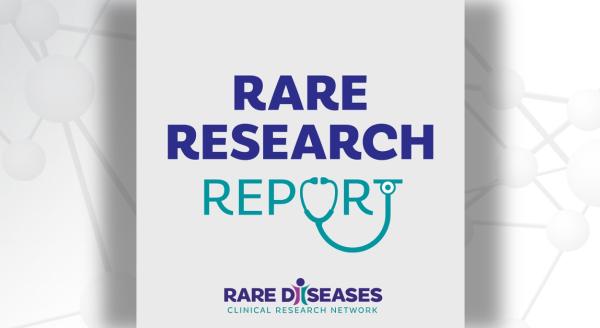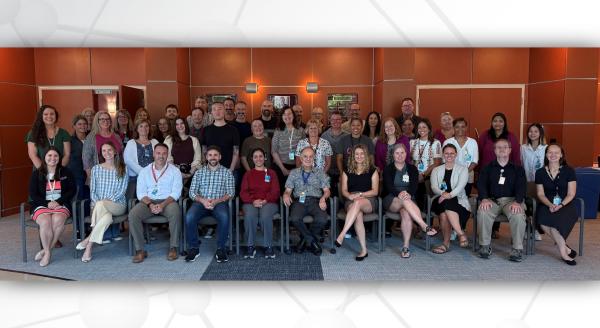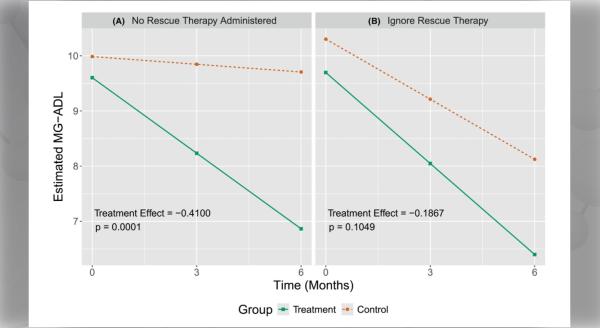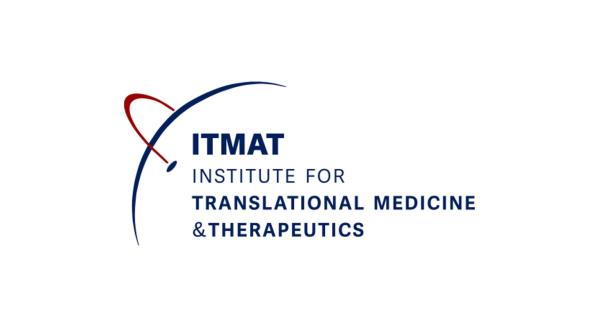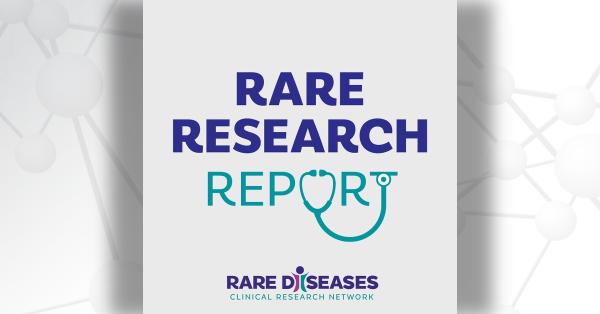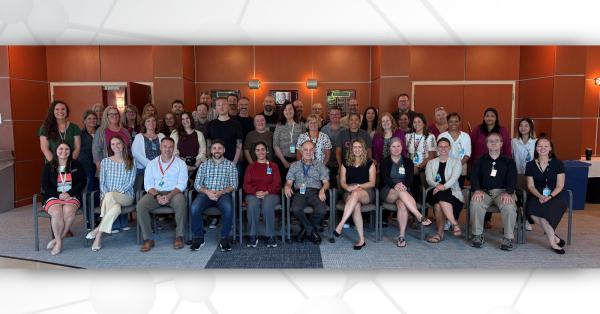Each month, we share summaries of recent Rare Diseases Clinical Research Network (RDCRN) grant-funded publications. Catch up on the latest RDCRN research below.
Jump to:
- Developmental Synaptopathies Consortium (DSC)
- Dystonia Coalition (DC)
- Frontiers in Congenital Disorders of Glycosylation Consortium (FCDGC)
- Global Leukodystrophy Initiative Clinical Trials Network (GLIA-CTN)
- Myasthenia Gravis Rare Disease Network (MGNet)
- Nephrotic Syndrome Study Network (NEPTUNE)
Listen to these summaries on the Rare Research Report podcast.
Developmental Synaptopathies Consortium (DSC)
Exploring the Relationship Between Genomic Diversity and Neurodevelopmental Versus Cancer Risks in Individuals with PTEN Hamartoma Tumor Syndrome
PTEN hamartoma tumor syndrome (PHTS) is a spectrum of disorders caused by mutations in the PTEN gene, which typically suppresses formation of tumors. Individuals with PHTS have increased risks of cancer and neurodevelopmental disorders, including autism spectrum disorder (ASD). Not much is known about why patients with PHTS are at increased risk for these seemingly unrelated outcomes.
In this study, researchers explored the relationship between genomic diversity and neurodevelopmental versus cancer risks in individuals with PHTS. The team analyzed the genotypes of 376 individuals with PHTS and grouped them according to clinical phenotypes of neurodevelopmental disorders (including ASD) and non-neurodevelopmental disorders (including cancer).
In the neurodevelopmental disorders group, results revealed an increased accumulation of homozygous common variants in genes involved in inflammatory processes. In the ASD group, researchers also found an increased accumulation of homozygous common variants in genes involved in differentiation and chromatin structure regulation. However, in the cancer group, the team found an increased accumulation of homozygous ultra-rare variants in genes modulating cell death.
Authors note that these findings suggest a new concept of genomic diversity as a modifier of neurodevelopmental and malignant phenotypes in those with PHTS. Results also demonstrate potential clinical utility—especially for neurodevelopmental phenotypes—for better PHTS patient management.
Kim AY, Yehia L, Eng C. Genomic diversity in functionally relevant genes modifies neurodevelopmental versus neoplastic risks in individuals with germline PTEN variants. NPJ Genom Med. 2025 May 20;10(1):43. doi: 10.1038/s41525-025-00495-3. PMID: 40394016; PMCID: PMC12092801.
Using Genome Sequencing to Identify Additional Molecular Diagnoses in Phelan-McDermid Syndrome
Phelan-McDermid syndrome (PMS) is a genetic neurodevelopmental disorder that results from the loss of a small piece of chromosome 22 or variants in the SHANK3 gene. Symptoms of PMS include intellectual disability, autism spectrum disorder, low muscle tone, and absent speech. However, these symptoms can vary widely from person to person, even among those with the same molecular cause.
In this study, researchers used genome sequencing to identify additional molecular diagnoses that may contribute to symptom variability in PMS. The team analyzed genome sequencing and chromosomal microarray in 20 individuals with PMS.
Results revealed a second molecular finding associated with a neurological condition in three participants. Five additional new molecular diagnoses were associated with a clinically actionable secondary or incidental finding. Authors note that this study provides early evidence for the potential use of expanded sequencing among individuals with PMS, even for those without symptoms outside of the expected range.
Moses RG, Similuk M, Hehn A, Duncan R, Pekar M, Gordon-Lipkin E, Acosta MT, Zeltser D, Reynolds-Lallement N, Soorya L, Sahin M, Levy T, Kolevzon A, Buxbaum JD, Berry-Kravis E, Powell CM, Bernstein JA, Tokita M, Seifert BA, Ghosh R, Walkiewicz MA, Thurm A. Genome Sequencing Uncovers Additional Findings in Phelan-McDermid Syndrome. Am J Med Genet B Neuropsychiatr Genet. 2025 Jun 16:e33036. doi: 10.1002/ajmg.b.33036. Epub ahead of print. PMID: 40519070.
Dystonia Coalition (DC)
Exploring Genetic Diversity and Phenotypes in Dystonia
Dystonia is one of the most prevalent movement disorders, characterized by involuntary muscle contractions leading to abnormal postures and repetitive movements. Due to the broad spectrum of clinical manifestations and the increasing number of dystonia-linked genes, not much is known about the correlations between clinical manifestations and genetic variants.
In this study, researchers explored genetic diversity and phenotypes in dystonia. The team used exome sequencing among 1,924 genetically unsolved, mainly late-onset isolated dystonia patients to examine and analyze rare variants in genes previously linked to dystonia.
Results revealed 137 pathogenic or likely pathogenic variants across 51 genes in 163 patients. Authors note that the findings provide crucial insights into the relevance of genetic forms of dystonia and their corresponding phenotypes, aiding future variant interpretation and clinical diagnostics.
Thomsen M, Ott F, Loens S, Kilic-Berkmen G, Tan AH, Lim SY, Lohmann E, Schröder KM, Ipsen L, Nothacker LA, Welzel L, Rudnik AS, Hinrichs F, Odorfer T, Zeuner KE, Schumann F, Kühn AA, Zittel S, Moeller M, Pfister R, Kamm C, Lang AE, Tay YW, de Almeida Marcelino AL, Vidailhet M, Roze E, Perlmutter JS, Feuerstein JS, Fung VSC, Chang F, Barbano RL, Bellows S, Wagle Shukla AA, Espay AJ, LeDoux MS, Berman BD, Reich S, Deik A, Franke A, Wittig M, Franzenburg S, Volkmann J, Brüggemann N, Jinnah HA, Bäumer T, Klein C, Busch H, Lohmann K. Genetic Diversity and Expanded Phenotypes in Dystonia: Insights From Large-Scale Exome Sequencing. Ann Clin Transl Neurol. 2025 Jun 18. doi: 10.1002/acn3.70100. Epub ahead of print. PMID: 40533913.
Frontiers in Congenital Disorders of Glycosylation Consortium (FCDGC)
Examining Metabolomic Changes in a Patient with PGM1-Congenital Disorder of Glycosylation and Leigh Syndrome
Inherited metabolic disorders (IMDs) are a large group of genetically inherited disorders that affect the metabolism. Although there are currently about 1,450 different types of IMDs, they are individually rare, and even more rare for one individual to have two IMDs.
In this study, researchers examined metabolism changes in a patient with pathogenic variants in the PGM1 and NDUFA13 genes. The team evaluated fibroblasts from the patient, who had presented with characteristics of both PGM1-congenital disorder of glycosylation (CDG) and Leigh syndrome (mitochondrial disease) to better understand the cause of these characteristics.
Results showed a depletion of the UDP-hexose enzyme as well as impairment of complex I enzyme activity and mitochondrial function. Based on these findings, the patient was diagnosed with the first-known case of both PGM1-CDG and Leigh syndrome. Authors note that this study underlines the importance of considering the effects of multiple disease-causing variants in patients with complex clinical presentation.
Radenkovic S, Adant I, Bird MJ, Swinnen JV, Cassiman D, Kozicz T, Gruenert SC, Ghesquière B, Morava E. Complex Metabolomic Changes in a Combined Defect of Glycosylation and Oxidative Phosphorylation in a Patient with Pathogenic Variants in PGM1 and NDUFA13. Cells. 2025 Apr 25;14(9):638. doi: 10.3390/cells14090638. PMID: 40358162; PMCID: PMC12071635.
Global Leukodystrophy Initiative Clinical Trials Network (GLIA-CTN)
Characterizing Diagnostic Delays in Metachromatic Leukodystrophy
Metachromatic leukodystrophy (MLD) is a rare inherited disorder that causes progressive damage to the nervous system. The subtypes of MLD are defined by the onset of neurodegeneration, but less is known about the earliest features of this inborn error in metabolism.
In this study, researchers found that many children experience subtle early features in the months to years prior to diagnosis. The early medical journeys of children were mapped using two independent payor-system databases. Every medical encounter prior to diagnosis was captured. Across these cohorts, they found that children frequently presented within the medical system with signs and symptoms of disease, including early developmental delay, feeding issues, gallbladder problems, and abnormal eye movements. This work was complemented by similar findings from an MLD natural history study, which is supported through the GLIA-CTN.
Authors note that this study highlights early features of MLD and defines barriers to diagnosis, further supporting the need for early screening. By better understanding the barriers to diagnosis and characterizing how MLD begins, we can better define clinical monitoring guidelines in presymptomatic children and define ideal windows for intervention to improve outcomes. This work underscores the critical need for newborn screening to definitively diagnose children prior to disease onset.
Mohajer A, Sevagamoorthy A, Bean K, Mutua S, Pang F, Adang LA. Characterizing Diagnostic Delays in Metachromatic Leukodystrophy: A Real-World Data Approach. J Inherit Metab Dis. 2025 Jul;48(4):e70049. doi: 10.1002/jimd.70049. PMID: 40457575; PMCID: PMC12130617.
Myasthenia Gravis Rare Disease Network (MGNet)
Developing an Artificial Intelligence-Based Assessment of Telehealth Examinations in Myasthenia Gravis
Myasthenia gravis (MG) is a neuromuscular disorder caused by an autoimmune response which blocks or damages acetylcholine receptors in muscles, causing disabling weakness. Although telemedicine is considered a positive tool for both MG patients and physicians, not much is known about its strengths and limitations for MG examinations.
In this study, researchers developed an artificial intelligence-based assessment of telehealth examinations in MG. The team studied video recordings of 51 patients with MG who completed two telemedicine-based examinations with neuromuscular experts. Researchers applied artificial intelligence algorithms including computer vision, speech analysis, and natural language processing to assess the reproducibility and reliability of the examinations.
Results showed that overall MG core examination scores were consistent across examiners. However, individual metrics showed up to 25% variability due to differences in examiner instructions, video recording limitations, and patient disease severity. Authors note that further refinement of this technology could enhance examiner training and reduce variability in clinical trial outcome measures.
Garbey M, Lesport Q, Girma H, Öztosun G, Kaminski HJ. A Quantitative Study of Factors Influencing Myasthenia Gravis Telehealth Examination Score. Muscle Nerve. 2025 Jul;72(1):34-41. doi: 10.1002/mus.28394. Epub 2025 Apr 2. PMID: 40176335; PMCID: PMC12140879.
Discussing the Impact of Rescue Therapy in Clinical Trials for Myasthenia Gravis
Myasthenia gravis (MG) is a neuromuscular disorder caused by an autoimmune response which blocks or damages acetylcholine receptors in muscles, causing disabling weakness. Clinical trials for MG aim to evaluate whether a new therapy can improve patients’ symptoms. However, if a study participant experiences worsening symptoms, they typically receive existing therapies to improve their condition. This type of intervention, called “rescue therapy,” could lead to inaccurate information if not appropriately addressed.
In this review, researchers discuss the impact of rescue therapy in MG clinical trials. The team reviews strategies for incorporating rescue therapy in the design and statistical analysis of MG trials, shows how each strategy affects the interpretation of trial results, and suggests circumstances when each strategy may or may not be applicable to patients or physicians.
Authors note that rescue therapy should be considered during the planning phase of clinical trials before designing the statistical analysis, which can improve the robustness of the study and alignment with regulatory recommendations.
Leach JM, Aban I, Cutter G, Benatar M. Handling rescue therapy in myasthenia gravis clinical trials: why it matters and why you should care. Ann Clin Transl Neurol. 2025 May;12(5):888-897. doi: 10.1002/acn3.52309. Epub 2025 Apr 16. PMID: 40241261; PMCID: PMC12093330.
Nephrotic Syndrome Study Network (NEPTUNE)
Exploring the Relationship Between Air Pollution and Primary Glomerular Diseases
Primary glomerular diseases are a group of conditions that affect kidney function by attacking the glomeruli, which are kidney structures responsible for filtering the blood and removing waste in urine. Recent studies suggest that air pollution contributes to the onset and progression of chronic kidney disease and, specifically, glomerular disease.
In this review, researchers summarize the major sources and components of air pollution, the relationship between air pollution exposure and chronic kidney disease, and the impact of air pollution on the progression of primary glomerular diseases. The team highlights important gaps in knowledge and the need for future collaborative work involving environmental scientists, epidemiologists, and nephrologists.
Authors note that air pollution exposure represents a potentially modifiable risk factor for chronic kidney disease progression that can be addressed by regulatory action, personal behaviors, and intervention to prevent or limit exposure.
Troost JP, Kshirsagar AV, Engel LS, O'Lenick CR, Smoyer WE, Klein J, Helmuth M, Mariani LH, Kretzler M, Smith AR, Lacey F, Trachtman H. Elevated exposure to air pollutants accelerates primary glomerular disease progression. Clin Kidney J. 2025 May 13;18(6):sfaf140. doi: 10.1093/ckj/sfaf140. PMID: 40474984; PMCID: PMC12138343.
The Rare Diseases Clinical Research Network (RDCRN) is funded by the National Institutes of Health (NIH) and led by the National Center for Advancing Translational Sciences (NCATS) through its Division of Rare Diseases Research Innovation (DRDRI). Now in its fourth five-year funding cycle, RDCRN is a partnership with funding and programmatic support provided by Institutes, Centers, and Offices across NIH, including the National Institute of Neurological Disorders and Stroke, the National Institute of Allergy and Infectious Diseases, the National Institute of Diabetes and Digestive and Kidney Diseases, the Eunice Kennedy Shriver National Institute of Child Health and Human Development, the National Institute of Arthritis and Musculoskeletal and Skin Diseases, the National Heart, Lung, and Blood Institute, the National Institute of Dental and Craniofacial Research, the National Institute of Mental Health, and the Office of Dietary Supplements.


